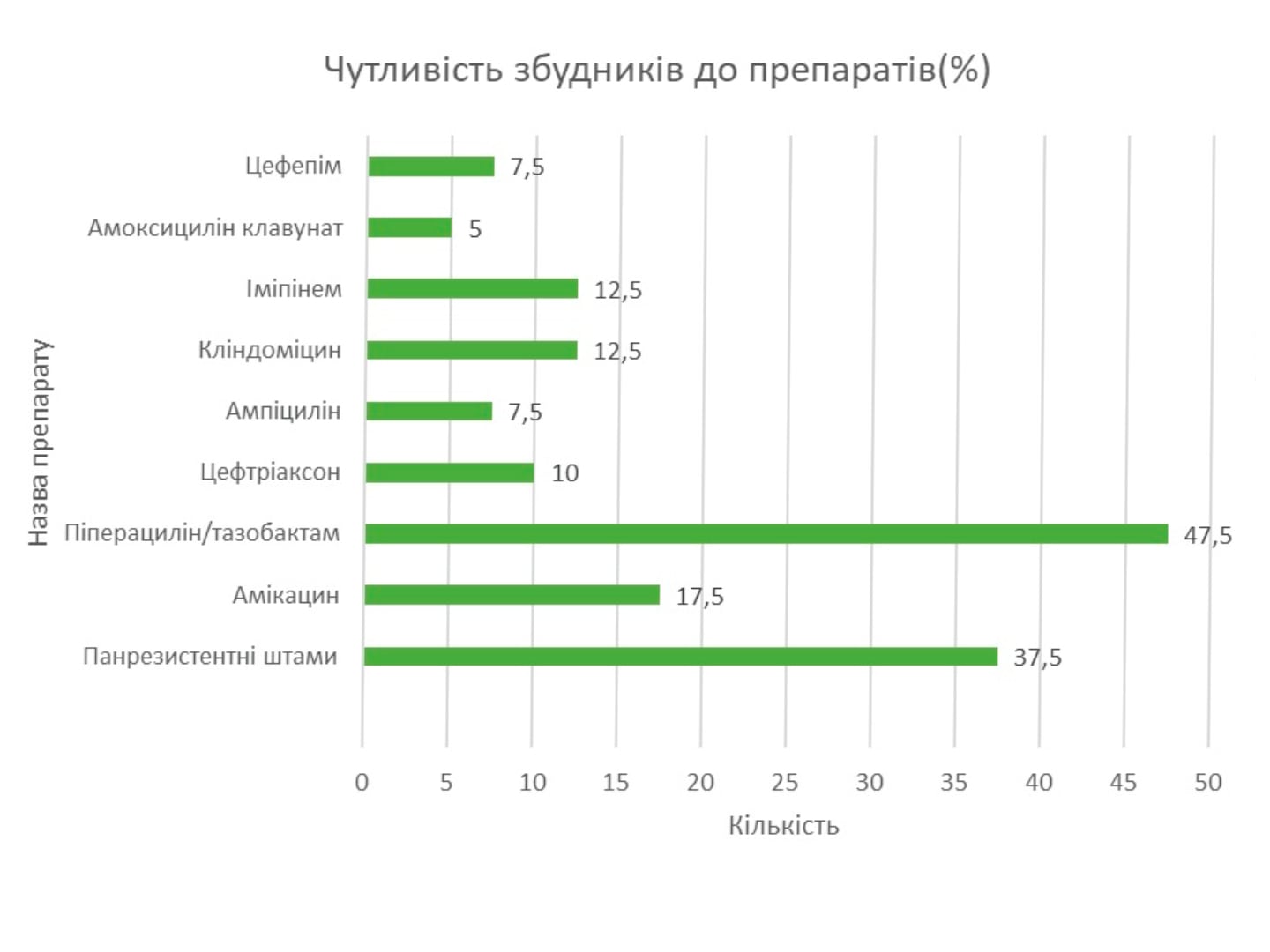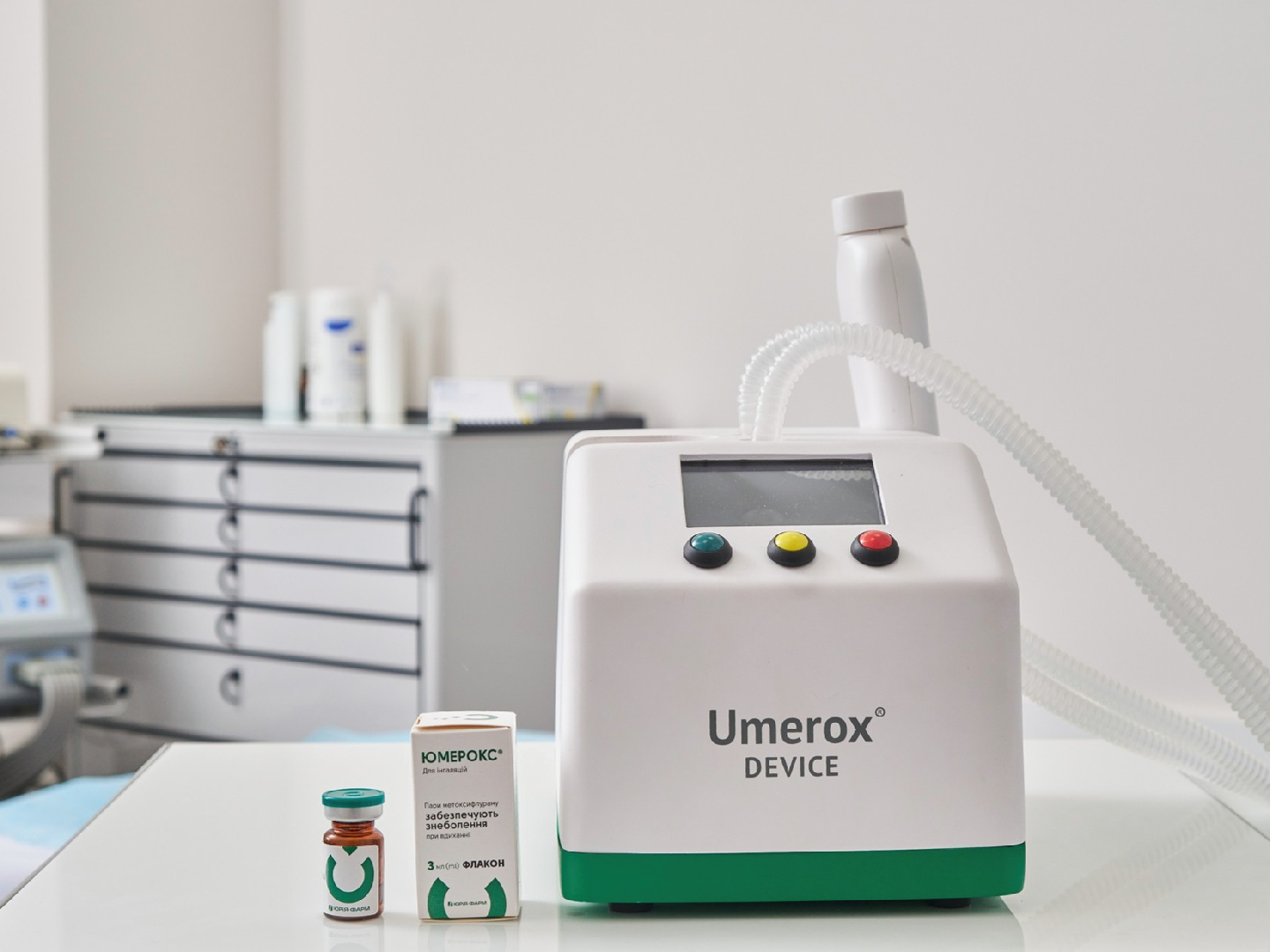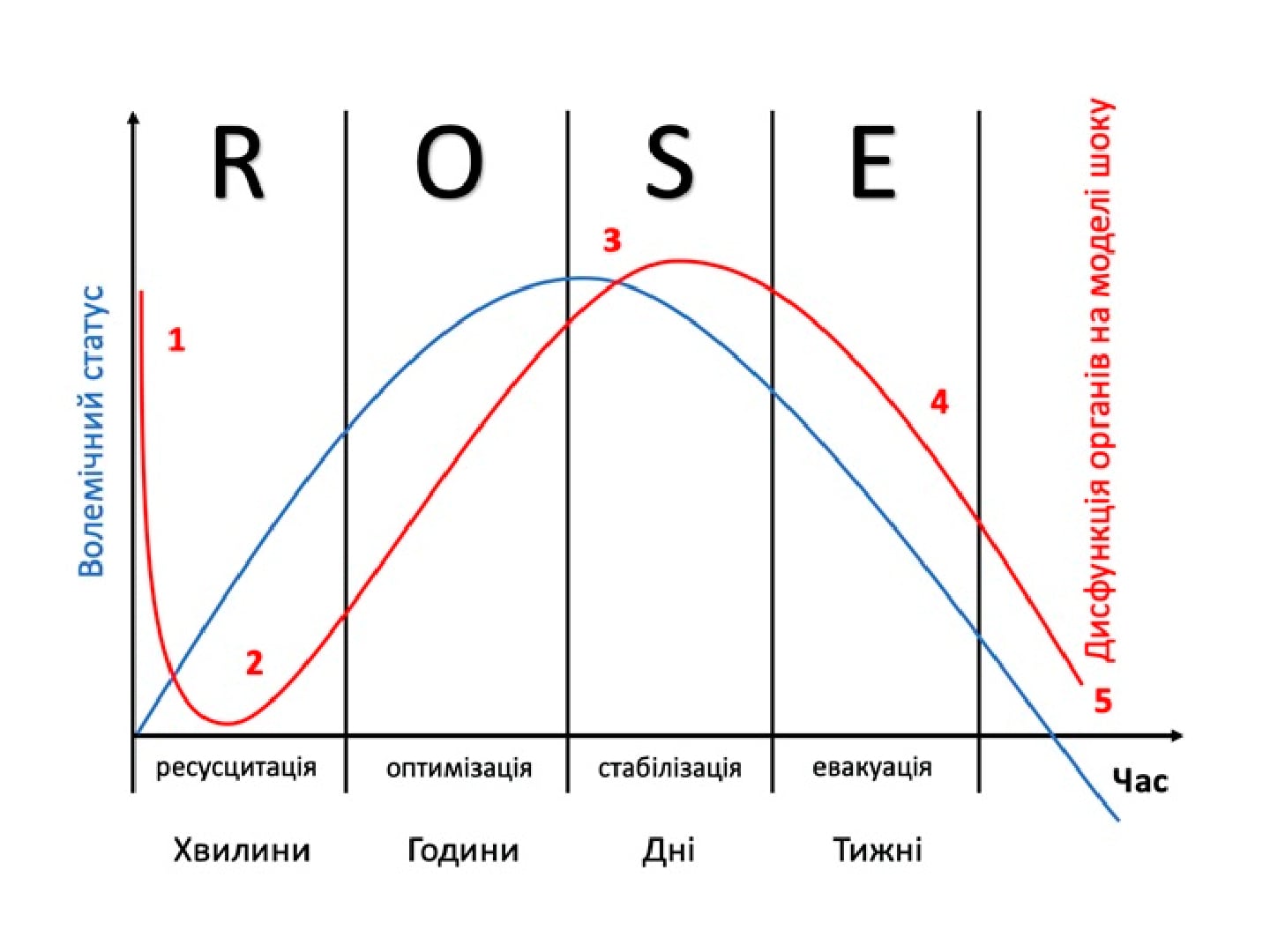The piperacillin/tazobactam role in the treatment of complicated intra-abdominal infections (cIAI) in Ukrainian hospitals: 40 clinical cases series analysis

Resume. Antibiotic therapy is one of the key components of complicated intra abdominal infection (cIAI) treatment. The challenge of effective treatment of cIAI is early recognition, adequate source control, appropriate antibacterial therapy, and fluid resuscitation in patients with sepsis. According to WHO recommendations, piperacillin / tazobactam is the first-line antibiotic for the treatment of complicated intra-abdominal infections, although it used quite rare as the first choice agent in Ukraine.
Materials and methods: Analysis was conducted in the period from December 1, 2022 to June 30, 2023. The research centers were 4 health care facilities: Communal non-commercial enterprise “Kyiv City Clinical Hospital of Emergency Medical Care”, Emergency medical care hospital of Vinnytsia, Communal non-commercial enterprise “Odesa Regional Clinical Hospital of the Odesa Regional Council”, Communal non-commercial enterprise “Kyiv City Clinical Hospital №4”. After inclusion in the research, patients were prescribed empiric therapy with piperacillin/tazobactam (Refex) and patient data were entered into a form. The results of drug therapy were recorded before the start of therapy (day 0), on the 3rd day after the start of therapy and on the 6th day after the start of therapy.
Results: 40 patients were included in the research. The most common pathogens cultured from patients wounds were: 24 cases (60%) from the “ESKAPE” group: E. Coli 9 cases (22.5%), S. Aureus 1 case (2.5%), St. Haemolyticus accounted for 3 cases (7.5%), Kl. Pneumonia 4 cases (10%), Acinetobacter spp. 1 case (2.5%) of Ps. Aeroginosa 3 cases (7.5%), Enterobacter 1 case (2.5%), Enterbacter cloaceae accounted for 2 cases (5%). Other pathogens were cultured in 16 cases.
Pathogens sensitivity were as follows: 2 cases (5%) were sensitive to amoxicillin clavunate, 3 cases (7.5%) were sensitive to ampicillin and cefepime, 4 cases (10% of pathogens) were sensitive to ceftriaxone, 12.5% of pathogens were sensitive to imipinem and clindamycin (5 cases each), 7 cases were sensitive to amikacin (17.5%). 47.5% of flora (19 cases) were sensitive to piperacillin/tazobactam. Pan-resistant strains that were not sensitive to any of the studied drugs accounted for 37.5% (15 cases).
Conclusions: Therapy with piperacillin / tazobactam (Refex) in all analyzed clinical cases was evaluated by doctors as effective and safe. All patients survived and were discharged from the hospital, none of them developed sepsis or acute kidney injury. Among the analyzed cases, the sensitivity to piperacillin/tazobactam was the highest.
Keywords: piperacilline/tazobactam, intraabdominal infections, antibiotic resistance.
Authors: Bielka K.Y., Fomina G.A., Goncharenko O.V., Zgrzheblovska L.V., Koychev E.A., Malysh I.R., Solarik S.O.
Literature:
- Sartelli M, Abu-Zidan FM, Catena F, Griffiths EA, Di Saverio S, Coimbra R, et al. Global validation of the WSES Sepsis Severity Score for patients with complicated intraabdominal infections: a prospective multicenter study (WISS Study). World J Emerg Surg. 2015;10(1):61.
- ІНСТРУКЦІЯ з впровадження адміністрування антимікробних препаратів в закладах охорони здоров’я, які надають медичну допомогу в стаціонарних умовах [Електронний ресурс]. – 2021. – Режим доступу до ресурсу: rada.gov.ua/laws/show/z1322-21#Text
- Ombajo L. A. WHO Model Lists of Essential Medicine [Електронний ресурс] / Ombajo. – 2023. – Режим доступу до ресурсу: essentialmeds.org/medicines/320
- Santajit S, Indrawattana N. Mechanisms of Antimicrobial Resistance in ESKAPE Pathogens. Biomed Res Int. 2016;2016:2475067. doi: 10.1155/2016/2475067.
- Cox MC, Brakenridge SC, Stortz JA, Hawkins RB, Darden DB, Ghita GL, et al. Abdominal sepsis patients have a high incidence of chronic critical illness with dismal long-term outcomes. Am J Surg. 2020;220(6):1467–74.
- Stijn Blot,1Massimo Antonelli,2,3 Kostoula Arvaniti,4 Koen Blot,1 Ben Creagh-Brown,5,6Intensive Care Med. 2019; 45(12): 1703–1717. Published online 2019 Oct 29. doi: 1007/s00134-019-05819-3 PMCID: PMC6863788 PMID: 31664501
- Фомін П. Д.Нерадикальні операції в хірургічному лікуванні гострокровоточивих злоякісних пухлин шлунка / П. Д. Фомін, П. В. Іванчов // Військова медицина України. – 2011. – Т. 11, № 1. – С. 62-66. – Режим доступу: gov.ua/UJRN/vmuk_2011_11_1_11
- Мамчич В. И.Особенности диагностики и лечения острого панкреатита у беременных / В. И. Мамчич, О. В. Голяновский, И. В. Кандаурова, Т. Ю. Пилипенко, М. А. Йосипенко, Ю. О. Литвинец // Хірургія України. – 2015. – № 4. – С. 28-32. – Режим доступу: gov.ua/UJRN/KhU_2015_4_6
- Polk HC Jr, Fink MP, Laverdiere M, Wilson SE, Garber GE, Barie PS, Hebert JC, Cheadle WG. Prospective randomized study of piperacillin/tazobactam therapy of surgically treated intra-abdominal infection. The Piperacillin/Tazobactam Intra-Abdominal Infection Study Group. Am Surg. 1993 Sep;59(9):598-605. PMID: 8396374.
- Results of the North American trial of piperacillin/tazobactam compared with clindamycin and gentamicin in the treatment of severe intra-abdominal infections. Investigators of the Piperacillin/Tazobactam Intra-abdominal Infection Study Group. Eur J Surg Suppl. 1994;(573):61-6. PMID: 7524798.
- Протокол надання медичної допомоги хворим на негоспітальну та нозокоміальну (госпітальну) пневмонію у дорослих осіб: етіологія, патогенез, класифікація, діагностика, антибактеріальна терапія. Затверджений наказом МОЗ України від 19 березня 2007 р. № 128. Доступно за адресою: ifp.kiev.ua/doc/staff/MOZ-128-19032007.pdf.
- Sartelli M, Weber DG, Ruppé E, Bassetti M, Wright BJ, Ansaloni L, et al. Antimicrobials: a global alliance for optimizing their rational use in intra-abdominal infections (AGORA). World J Emerg Surg. 2016;11(1):33. org/10.1186/s13017-016-0089-y.
- Nordmann P, Cuzon G, Naas T. The real threat of Klebsiella pneumoniae carbapenemase-producing bacteria. Lancet Infect Dis. 2009;9(4):228–36. org/10.1016/S1473-3099(09)70054-4.
- Morrissey I, Hackel M, Badal R, Bouchillon S, Hawser S, Biedenbach D. A review of ten years of the study for monitoring antimicrobial resistance trends (SMART) from 2002 to 2011. Pharmaceuticals (Basel). 2013;6(11):1335–46. org/10.3390/ph6111335.
- Schultsz C, Geerlings S. Plasmid-mediated resistance in Enterobacteriaceae: changing landscape and implications for therapy. Drugs. 2012;72(1):1–16.
- Sartelli, M., Coccolini, F., Kluger, Y. et al.WSES/GAIS/SIS-E/WSIS/AAST global clinical pathways for patients with intra-abdominal infections. World J Emerg Surg 16, 49 (2021). org/10.1186/s13017-021-00387-8.
- Sartelli M, Catena F, Ansaloni L, Coccolini F, Corbella D, Moore EE, Malangoni M, Velmahos G, Coimbra R, Koike K, Leppaniemi A, Biffl W, Balogh Z, Bendinelli C, Gupta S, Kluger Y, Agresta F, Di Saverio S, Tugnoli G, Jovine E, Ordonez CA, Whelan JF, Fraga GP, Gomes CA, Pereira GA, Yuan KC, Bala M, Peev MP, Ben-Ishay O, Cui Y, Marwah S, Zachariah S, Wani I, Rangarajan M, Sakakushev B, Kong V, Ahmed A, Abbas A, Gonsaga RA, Guercioni G, Vettoretto N, Poiasina E, Díaz-Nieto R, Massalou D, Skrovina M, Gerych I, Augustin G, Kenig J, Khokha V, Tranà C, Kok KY, Mefire AC, Lee JG, Hong SK, Lohse HA, Ghnnam W, Verni A, Lohsiriwat V, Siribumrungwong B, El Zalabany T, Tavares A, Baiocchi G, Das K, Jarry J, Zida M, Sato N, Murata K, Shoko T, Irahara T, Hamedelneel AO, Naidoo N, Adesunkanmi AR, Kobe Y, Ishii W, Oka K, Izawa Y, Hamid H, Khan I, Attri A, Sharma R, Sanjuan J, Badiel M, Barnabé R. Complicated intra-abdominal infections worldwide: the definitive data of the CIAOW Study. World J Emerg Surg. 2014 May 14;9:37. doi: 10.1186/1749-7922-9-37. PMID: 24883079; PMCID: PMC4039043.






